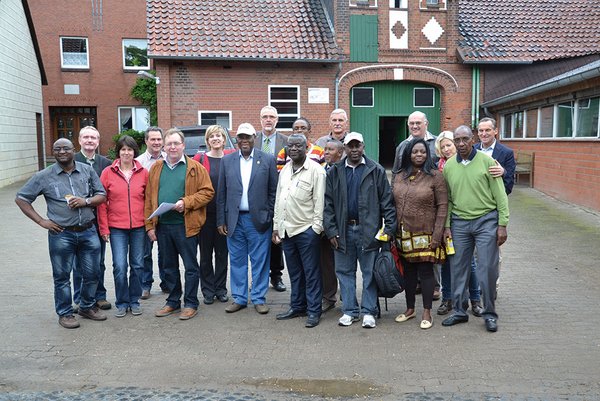 Download this article in magazine layout
Download this article in magazine layout
- Share this article
- Subscribe to our newsletter
Machinery rings – a mechanisation concept for African farmers?
African agriculture is mainly characterised by small-scale structures, and the level of mechanisation is very low. European farms faced a similar situation after the Second World War. With the aid of machinery rings, they quickly achieved a higher degree of mechanisation. Furthermore, it became apparent that machinery rings can significantly contribute to socio-economic development in rural areas by boosting income generation, enhancing livelihoods and contributing to food security.
In this context, leading representatives – small as well as large-scale farmers – of the Southern African Confederation of Agricultural Unions (SACAU) had been invited by the German Farmers’ Association (DBV) to a one-week study tour to Germany in May 2014 to discuss key conditions for the success of machinery rings. The ideas and impressions obtained are to support the development of a tailor-made strategy for African countries.
But what exactly is a machinery ring? It is an association of individual farmers with the aim of sharing agricultural machinery and equipment. Thus the concept improves access to technology for farmers, as it provides a financing strategy to purchase and share agricultural machinery, including technical maintenance and repair services. The farmers can contribute to minimise production costs, improve working conditions, provide operational assistance for social welfare (Betriebshilfe) and optimise management structures through consultation and exchange of workers and services. In some parts of Germany, machinery rings represent an important economic factor and create employment in rural areas. The first machinery rings in Germany were established in the 1960s. Today the Federal Association of Machinery Pools (BMR) has 263 machinery rings and 193,100 members. The Federal Association is divided into twelve sub-national associations.
What are hurdles for the establishment of machinery rings in Africa? Which framework conditions are needed? These were some of the key questions to be answered during the tour. “It is not only about the establishment of a single machinery ring, it’s about the development of a comprehensive strategy which considers the whole value chain,” Theo de Jager, President of SACAU, stressed. He had a long-term perspective for the development of machinery rings in mind. Southern Africa especially lacked functioning value chains, financing, technology and expertise, Mr de Jager said. Mechanisation, particularly through the establishment of machinery rings, could be the key to addressing these issues. In order to succeed, contributions from and co-operation among different stakeholders (e.g. farmers, the government, investors, contractors, donors, the machinery ring itself, other machinery rings) were needed. It was necessary to include solutions for steering, management, financing, organisation, administration, legal framework, (advisory) services and maintenance in a long-term strategy, he stated. One option could be to start with pilot machinery rings in selected countries and subsequently establish a machinery ring at regional level (Southern Africa). In this case, there would be co-ordinating structures at national levels, whilst a regional organisation could take over duties such as training, IT support, donor liaison or liaising with SADC. “We will not get Africa‘s under-utilised land under production with a hand hoe,” Mr de Jager said, emphasising the importance of mechanisation.
During discussions on the development of a concept note for framework conditions, it was proposed that existing organisation structures be used as “docking stations” for machinery rings provided they met some basic conditions, for example the existence of producer organisations, functioning structures at all levels, business and service orientation, information flow, etc. Further, a healthy membership base, capacity for management, sources for finance (domestic and/or external), capacities/skills for operating machinery and access to markets should be in place. While large-scale farmers especially needed support in leasing, smaller farms required help with loans, the participants stressed. They were convinced that the concept was applicable in their countries. This assessment was also shared by Willi Kampmann, Head of the DBV Unit International Relations in Brussels, who stated: “Farmers need to be politically and economically independent. Machinery rings are one successful example of efficient organisation and how it can contribute to the sustainability of family farms and to achieve food security. What has succeeded here does not necessarily work in other countries, but German experiences can provide a useful input.”
Katharina Schlemper
Development Cooperation Scout,
German Farmers’ Association
(Deutscher Bauernverband e.V. – DBV)





Add a comment
Comments :